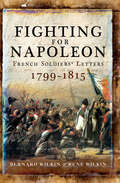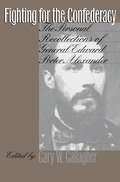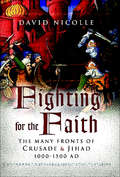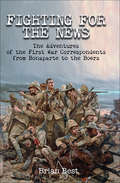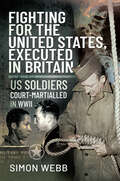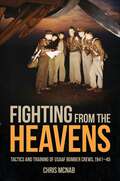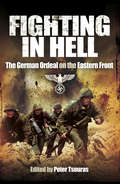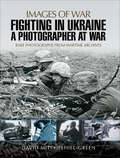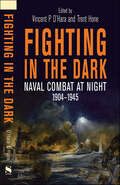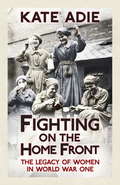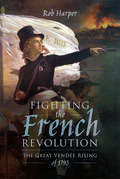- Table View
- List View
Fighting for Napoleon's Army in Russia: A POW's Memoir
by C.J. WagevierIn 1812 the French emperor Napoleon decided to invade Russia. For this purpose, he gathered an army of half a million men and women, consisting of soldiers from all nationalities, including French, German and Italian. Serving in this army was Carel Johannes Wagevier, an officer in the 125th Regiment of the Line, which was staffed by mostly Dutch soldiers. Full of confidence, they went to war and began the long journey to the East. What followed was a horrific expedition deep into the Russian interior, a chaotic retreat, and captivity. Just like his fellow soldiers, Wagevier endured the cold, the stresses of combat, and the hunger that besieged the army. After fighting at the battle of Berezina in November 1812, he was taken prisoner and transported all the way to the Russian interior. In 1814 he and his remaining fellow officers were released, and together they started the journey back home. During his travels across Russia, he made notes of events that occurred or meetings that seemed memorable, including ones of unexpected generosity as well as sudden cruelty. These notes were later expanded into his memoir and published in 1820. Now, for the first time ever, they have been translated into English, providing a unique and fascinating insight into the life of a solider in Napoleon’s army.
Fighting for Napoleon: French Soldiers' Letters, 1799–1815
by Bernard Wilkin René WilkinTrue, first-hand accounts of combat and soldiering from the men who fought for Napoleon Bonparte and the First French Empire: &“Fascinating stuff&” (Stuart Asquith, author of Military Modelling). The French side of the Napoleonic Wars is often presented from a strategic point of view, or in terms of military organization and battlefield tactics, or through officers&’ memoirs. Fighting for Napoleon:French Soldiers&’ Letters, 1799–1815, based on more than sixteen hundred letters written by French soldiers of the Napoleonic armies, shares the perspectives and experiences of the lowest, ordinary ranks of the army who fought on the frontlines. Authors Bernard Wilkin and René Wilkin provide an informative read of common soldiers&’ lives for military and cultural historians as well as a fascinating counterpoint to the memoirs of Cpt. Jean-Roch Coignet, Col. Marcellin de Marbot, or Sgt. Adrien Bourgogne. &“A superb guide to the experience and motivation of military service that is based on a wide trawl of relevant letters . . . A first-rate work that is of much wider significance.&” —Professor Jeremy Black, author of The Battle of Waterloo &“Provides the reader with a good insight into the lives of ordinary French of the Napoleonic Wars . . . Direct accounts of campaigns and battle, recruitment and training, barrack life, the experience of captivity and being wounded are all here, based on letters written most by uneducated men to their immediate family . . . This really is fascinating stuff, and surely a &‘must&’ for students of Napoleonic warfare.&” —Stuart Asquith, author of Military Modelling: Guide to Solo Wargaming
Fighting for Uncle Sam: Buffalo Soldiers in the Frontier Army
by John P. LangellierA chronicle of the first generation of black soldiers to serve in the US Army with images from more than a century of African American military history.From the American Revolution to the present day, African Americans have stepped forward in their nation’s defense. This book breathes new vitality into a stirring subject, emphasizing the role men who have come to be known as “buffalo soldiers” played in opening the Trans-Mississippi West. This concise overview reveals a cast of characters as big as the land they served. More than150 images painstakingly gathered over nearly a half century from public and private collections enhance the written word as windows to the past. Now, 150 years after Congress authorized African Americans to serve in the Regular Army, the reader literally can peer into the eyes of formerly enslaved men who bravely bought their freedom on the bloody battlefields of the Civil War, then trekked westward, carried the “Stars and Stripes” to the Caribbean, and pursued Pancho Villa into Mexico with John “Black Jack” Pershing.
Fighting for a Living: A Comparative Study of Military Labour 1500-2000 (Work around the Globe: Historical Comparisons)
by Erik-Jan ZürcherFighting for a Living investigates the circumstances that have produced starkly different systems of recruiting and employing soldiers in different parts of the globe over the last 500 years. It does so on the basis of a wide range of case studies taken from Europe, Africa, America, the Middle East and Asia. The novelty of Fighting for a Living is that it is not military history in the traditional sense (concentrating at wars and battles or on military technology) but that it looks at military service and warfare as forms of labour, and at the soldiers as workers. Military employment offers excellent opportunities for this kind of international comparison. Where many forms of human activity are restricted by the conditions of nature or the stage of development of a given society, organized violence is ubiquitous. Soldiers, in one form or another, are always part of the picture, in any period and in every region. Nevertheless, Fighting for a Living is the first study to undertake a systematic comparative analysis of military labour. It therefore speaks to two distinct, and normally quite separate, communities: that of labour historians and that of military historians.
Fighting for the Confederacy
by Gary W. GallagherOriginally published by UNC Press in 1989, Fighting for the Confederacy is one of the richest personal accounts in all of the vast literature on the Civil War. Alexander was involved in nearly all of the great battles of the East, from First Manassas through Appomattox, and his duties brought him into frequent contact with most of the high command of the Army of Northern Virginia, including Robert E. Lee, Stonewall Jackson, and James Longstreet. No other Civil War veteran of his stature matched Alexander's ability to discuss operations in penetrating detail-- this is especially true of his description of Gettysburg. His narrative is also remarkable for its utterly candid appraisals of leaders on both sides.
Fighting for the Faith: The Many Fronts of Crusade & Jihad 1000-1500 AD
by David NicolleFighting between Christians and Muslims in the medieval period is often seen in the narrow context of the battle for the Holy Land. Other points of conflict tend to be ignored. But, as David Nicolle's thought-provoking survey shows, the religions clashed across the medieval world - in the Mediterranean and the Iberian peninsula, in the Near East, in Central Asia, India, the Balkans, Anatolia, Russia, the Baltic and Africa. Over 500 years, the struggle in each theatre of conflict had its own character - methods of warfare differed and developed in different ways and were influenced by local traditions and circumstances. And these campaigns were not waged solely against Christian or Islamic enemies, but against pagan, non-Christian or non-Islamic peoples. As he tells the story of Crusade and Jihad, and describes the organization and tactics of the armies involved, David Nicolle opens up a new understanding of the phenomenon of holy war.
Fighting for the French Foreign Legion: Americans who joined the First World War in 1914
by Nils Elmark"Author Nils Elmark tackles the life and times of several notable Americans – primarily aviator Eugene Bullard, poet Alan Seeger and North African adventurer David Wooster King – against their impact on the war and their personal exploits while never losing sight of the overall context in which these events occurred. It is well written, easy to read and woven together as a single fabric." — Indy Squadron Dispatch On 24 August 1914, forty-four Americans joined the Foreign Legion and “with a cowboy swing” marched through Paris, wildly cheered by the crowd. They were Ivy League graduates, artists and dreamers and soldiers of fortune starting on equal terms as recruits in the French Army. They were the first Americans in the Great War, driven by a love for France and a thirst for adventure with no idea of the horrors awaiting them. This book is the amazing story of these American legionnaires told by three of the young volunteers: • David Wooster King – a 21-year-old dropout from Harvard, son of a rich businessman. King survived four years in the trenches ending as an officer in the US Army chasing German spies in Switzerland. He became a modern global adventurer and when the world went to war again David King was the first to volunteer for an even greater adventure in North Africa. • Alan Seeger – a 26-year-old poet and dreamer from a New York family of intellectuals. Seeger was killed during the Battle of the Somme on 4 July 1916. Six weeks earlier, he wrote the famous poem, ‘I Have a Rendezvous with Death’ which was to become his legacy and the favorite poem of President Kennedy. It has inspired a line of American presidents during the 20th century and is an indestructible poetic lifeline linking France and the United States of America. • Eugene James Bullard – the last of the three legionnaires and a 19-year-old entertainer and boxer from Columbus, Georgia. His father was born a slave, his mother was Creek Indian. Although wounded at Verdun and invalided out of the French Army, Bullard became the world’s first black aviator. After the war he settled in Paris and ran a bar in Montmartre before going to war for France again in 1940. The three men represent different pillars of the American soul, and their lives and dreams symbolize the story of how America became modern and remind us of the strong historic ties between France and America. Most of all, this book is a fantastic saga of brave men, great adventures and terrific sacrifices that bring hope and a new direction in a time of human division.
Fighting for the French Foreign Legion: Memoirs of a Scottish Legionnaire
by Alex LochrieA soldier’s true story of danger and adventure as a modern-day legionnaire in Kuwait, Bosnia, and beyond. With no French language ability, Alex Lochrie approached recruiters for the French Foreign Legion in Paris and embarked on the demanding selection process that followed. When he was accepted, he and other prospective legionnaires were sent to Southern France to begin the harsh recruit training course. The mix of nationalities and backgrounds among his fellows was enormous. New members are traditionally allowed to change their identities—and Lochrie chose to alter his age, becoming twenty-eight instead of thirty-eight. Elite paratrooper training followed in Corsica before Lochrie earned his wings. The FFL is never far from the front line, and in this book he tells of challenging active service in former French colonies in Africa as well as during the first Gulf War, evicting Saddam Hussein from Kuwait, and operations in Bosnia and Sarajevo. This gripping account lifts the veil of mystery and myth, pulling you into the action—and revealing much about the realities of service in the Foreign Legion.
Fighting for the News: The Adventures of the First War Correspondents from Bonaparte to the Boers
by Brian BestThe incredible true stories of the first reporters from the battlefield—from Europe&’s Napoleonic era to the Boer Wars of South Africa. Over two centuries ago, newspapers first considered sending a reporter overseas to observe, gather information, and write about war. With no experience to draw upon, both newspapers and correspondents gradually worked out a procedure that has evolved into today&’s incredibly sophisticated systems of reportage. Here are the gripping accounts of those groundbreaking adventurers who sought out the danger of battle in pursuit of a story. Included within are the exploits of such journalistic luminaries as the first real war correspondent, Henry Crabb Robinson, who was sent by The Times of London to act as their &‘man in Germany&’, ostensibly to follow and report the movements of Napoleon&’s Grande Armée; William Howard Russell in the Crimean War, whose reports helped change the British government&’s treatment of their soldiers; and perhaps the most famous correspondent of all, a young Winston Churchill who reported on conflicts in Cuba, the Indian frontier, Sudan, and the Boer War. For any fan of history, journalism, or true-life adventures, Fighting for the News is all you need to get the full story.
Fighting for the Trauma Doc's Heart: Pacific Paradise, Second Chance / Fighting For The Trauma Doc's Heart (Mills And Boon Medical Ser.)
by Rachel DoveFrom professional rivals…To a family of three?Ex-army doc Jacob Peterson is still adjusting to life as a single dad when his job is threatened by returning trauma doc Michelle Forbes. The sparks of animosity with the smart, sassy doc soon turn to attraction. But there’s room in Jacob’s life for only one girl—his daughter—and he can’t risk her heart, or his, again. Resisting his growing bond with Michelle will be the fight of his life!
Fighting for the United States, Executed in Britain: US Soldiers Court-Martialled in WWII
by Simon WebbThis book relates a chapter of American military history which many people would rather forget. When the United States came to the aid of Britain in 1942, the arrival of American troops was greeted with unreserved enthusiasm, but unfortunately, wartime sometimes brings out the worst, as well as the best, in people. A small number of the soldiers abused the hospitality they received by committing murders and rapes against British civilians. Some of these men were hanged or shot at Shepton Mallet Prison in Somerset, which had been handed over for the use of the American armed forces. Due to a treaty between Britain and America, those accused of such offences faced an American court martial, rather than a British civilian court, which gave rise to some curious anomalies. Although rape had not been a capital crime in Britain for over a century, it still carried the death penalty under American military law and so the last executions for rape in Britain were carried out at this time in Shepton Mallet. Fighting For the United States, Executed in Britain tells the story of every American soldier executed in Britain during the Second World War. The majority of the executed soldiers were either black or Hispanic, reflecting the situation in the United States itself, where the ethnicity of the accused person often played a key role in both convictions and the chances of subsequently being executed.
Fighting from the Heavens: Tactics and Training of USAAF Bomber Crews, 1941–45
by Chris McNab"...expands our knowledge of bomber operations, making it a most welcome addition to the aerial combat literature." — The Journal of America's Military Past During World War II, the US Army Air Forces (USAAF) projected American military might across distances and with destructive force unimaginable just a decade previously. The B-17s and B-24s of the US Eighth Air Force, for example, turned much of Germany’s infrastructure to twisted steel and burnt rubble between 1943 and 1945. B-29 Superfortresses unleashed conventional raids on Japan of even greater area destruction than that created by the atomic bomb attacks (also delivered by USAAF crews). Beyond heavy strategic bombing, US bombers performed a multitude of other tactical roles, including hunting Axis submarines, bombing enemy shipping, low-level runs against precision targets, and providing heavy air support to advancing infantry and armor. While the US bombers dealt out violence, however, they were also prey to a terrifying spectrum of antiaircraft threats, and by the end of the war 88,119 US airmen had died in service. Bomber crews were a world unto themselves, composed of pilots, co-pilots, engineers, navigators, wireless operators, gunners, and bombardiers. And each aircraft type had its own unique characteristics and capabilities, from twin-engine B-25 Mitchells designed for strafing and skip-bombing to the four-engine workhorses of the strategic bombing campaign: the B-17 Flying Fortress, B-24 Liberator, and B-29 Superfortress. Fighting from the Heavens: Tactics and Training of USAAF Bomber Crews, 1941–45 presents an invaluable collection of material from US wartime manuals, including doctrinal, training, technical, aircraft-specific, and position-specific publications. Through these manuals, the reader gains an insider’s insight into the demands of US bomber warfare, including long-distance navigation, gun-turret operation, formation flying, bomber start-up procedures, and bomb aiming.
Fighting in Hell: The German Ordeal on the Eastern Front
by Peter TsourasDetailed reports by German commanders: &“Powerful testimony to the Germans&’ lack of preparation for the harsh climatic conditions of the Russian winter.&” —Military Machines International When their troops invaded the Soviet Union in 1941, the initial success convinced the German high command that the Red Army could be destroyed west of the Dnepr River and that there would be no need for conducting operations in cold, snow, and mud. They were wrong. In fact, the German war in Russia was so brutal in its extremes that all past experience paled beside it. Everything in Russia—the land, the climate, the distances, and above all the people—were harder, harsher, more unforgiving, and deadlier than anything the German soldier had ever faced before. One panzer-grenadier who fought in the West and in Russia summed it up: In the West war was the same honorable old game; nobody went out of his way to be vicious, and fighting stopped often by five in the afternoon. But in the East, the Russians were trying to kill you—all the time. The four detailed reports of campaigning in Russia included in this invaluable book (Russian Combat Methods in WWII, Effects of Climate on Combat in European Russia, Combat in Russian Forests and Swamps and Warfare in the Far North) were written in the late 1940s and early 1950s as part of the US Army program to record the German strategies and tactics of World War II directly from the commanders. The authors were all veterans of the fighting they described, and frankly admitted that the soldiers sent to Russia were neither trained nor equipped to withstand the full fury of the elements. Fighting in Hell shows what happened on the ground, through firsthand accounts of the commanders who were there.
Fighting in Normandy: The German Army from D-Day to Villers-Bocage
by David C. IsbyCollected in-depth accounts from Nazi commanders chronicling their efforts to fight back against the Allied invasion at Normandy during World War II. The Allied landings on the Normandy beaches in June 1944 were brilliantly executed but proved to be just the opening phase of a desperately fought battle. The German Army responded to the invasion with as much ferocity and force as it could muster, and turned the struggle into a brutal and prolonged campaign. These in-depth reports by German commanders given the task of turning the tables on the invaders is crucial to a full understanding of the battle for Normandy. The accounts David Isby has selected, all written soon after the war&’s close for American military intelligence, cover German attempts to stem the invasion, dramatic defensive battles in the Norman countryside and attempts to implement a series of counterattacks. This vital source material presents the German perspective on the fighting, from regimental to corps level, and graphically illustrates the wealth of problems faced by an army on the very brink of destruction.
Fighting in Ukraine: A Photographer at War (Images of War)
by David Mitchelhill-GreenThis WWII pictorial history shares the personal images captured by a German photographer and soldier who fought on the Eastern Front. The outcome of the Second World War was decided on the Eastern Front. Denied a swift victory over Stalin&’s Red Army, Hitler&’s Wehrmacht found itself in a bloody, protracted struggle that it was ill-prepared to fight. Fighting in the Ukraine captures the drama and struggle of the Eastern Front through the extraordinary personal record of a professional photographer, Walter Grimm, who served in the German Army in a communications unit. David Mitchelhill-Green brings Grimm&’s previously unpublished photographs together with a highly informative introduction. The 300 evocative black and white images provide an absorbing insight into the daily life and privations of the ordinary German soldier amid the maelstrom of history&’s largest conflict. The Ukrainian people, many of whom initially welcomed the Germans as liberators, freeing them from Bolshevik oppression, are also chronicled in this fascinating photographic study.
Fighting in the Dark: Naval Combat at Night, 1904–1945
by Vincent O’Hara and Trent HoneFighting in the Dark is a new book about naval combat at night; the title also, however, signifies the overarching theme of the book, of moving from dark to light: in short, the process of mastering technological change during war. The authors start with the proposition that it is hard to hit an invisible target, particularly one in motion. In the nineteenth century, when ships relied upon visual signaling and vessels beyond hailing range were deaf and mute in the dark, night battles at sea were rare and largely accidental. Three inventions changed this: the torpedo, the searchlight, and the radio. These inventions at the end of the nineteenth and start of the twentieth centuries transformed naval warfare by making combat in the dark feasible and in some cases, desirable. The process by which navies used the dark and adapted it into a medium for effective combat was long and difficult, more so for some than others. This book is about that process and about how Russian, British, German, Italian, Japanese and US navies confronted the specific new challenges and adapted to unfamiliar situations and emerging technologies. Fighting in the Dark consists of chapters written by a group of highly respected naval historians, and the book’s approach illuminates how different navies and cultures approached common problems. The fierce night-time battles that are described serve as a metaphor for the larger issues and the reader is led along a fascinating journey of naval warfare from the Russo-Japanese War, through WWI, to the Second World War, and from the Pacific to the English Channel.
Fighting in the Shadows: Untold Stories of Deaf People in the Civil War
by Harry G. LangThis visually rich volume presents Harry G. Lang’s groundbreaking study of deaf people’s experiences in the Civil War. Based on meticulous archival research, Fighting in the Shadows reveals the stories of both ordinary and extraordinary deaf soldiers and civilians who lived through this transformative period in American history. Lang documents the participation of deaf soldiers in the war, whose personal tests of fortitude and perseverance have not been previously explored. There were also many deaf people in noncombat roles whose stories have not yet been told—clerks and cooks, nurses and spies, tradespeople supporting the armies, farmers supplying food to soldiers, and landowners who assisted (or resisted) troops during battles. Deaf writers, diarists, and artists documented the war. Even deaf children contributed actively to the war efforts. Lang pieces together hundreds of stories, accompanied by numerous historical images, to reveal a powerful new perspective on the Civil War. These soldiers and civilians were not “disabled” by their deafness. On the contrary, despite the marginalization and paternalism they experienced in society, they were able to apply their skills and knowledge to support the causes in which they ardently believed. Fighting in the Shadows is a story of how deaf civilians and soldiers put aside personal concerns about deafness, in spite of the discrimination they faced daily, in order to pursue a cause larger than themselves. Yet their stories have remained in the shadows, leaving most Americans, hearing and deaf, largely unaware of the deaf people who made significant contributions to the events that changed the course of our nation’s history. This book provides new insights into Deaf history as well as into mainstream interpretations of the Civil War.
Fighting in the Sky: The Story in Art
by John Fairley&“The thoughtful text and assortment of paintings illustrate just over a century of military aviation, from those early biplanes . . . to modern drones.&” —Military Model Scene Barely a decade passed from the Wright Brothers&’ first powered flight to aircraft becoming lethal instruments of war. The Royal Flying Corps and Royal Naval Air Service took off in the very early days of The Great War and captured the public&’s imagination and admiration. Sydney and Richard Carline happened to be both pilots and artists as was Frenchman Henri Farre. Their works inspired celebrated painters like Sir John Lavery who took to the skies in an airship in the First World War. Feeding on the demand for works depicting this new dimension of warfighting, a new genre of art was born which has remained popular ever since. During the Second World War, the paintings of Paul Nash stood out as did Eric Ravilious who, ironically, died in an air crash. War artist Albert Richards dropped with British paratroopers on D-Day. Post-war, paintings by leading British and international artists graphically illustrate conflicts such as the Falklands, Bosnia and the Gulf War. John Fairley has brought together a dazzling collection of art works covering over 100 years of air warfare, enhanced by lively and informative text. The result is a book that is visually and historically satisfying.&“This book is highly recommended based upon the outstanding prose, spectacular artwork, and coverage of the histories of the conflicts covered.&” —IPMS/USA&“Taken together, the paintings and descriptions present a compelling tableau of the first century of military operations in the third dimension.&” —Aviation History Magazine
Fighting on Two Fronts
by James E. WestheiderThe racial tensions that have long plagued American society exist to a much lesser extent in the military where the bond of common pursuit and shared experience renders race less relevant. Or so conventional wisdom has long held. In this dramatic history of race relations during the Vietnam war, James E. Westheider illustrates how American soldiers in Vietnam grappled with many of the same racial conflicts that were tearing apart their homeland thousands of miles away. Over seven years in the making, Fighting on Two Fronts draws on interviews with dozens of Vietnam veterans--black and white--and official Pentagon documents to paint the first complete picture of the African American experience in Vietnam. Westheider reveals how preconceptions and petty misunderstandings often exacerbated racial anxieties during the conflict. Military barbers, for instance, were often inexperienced with black hair, leading black soldiers to cut each other's hair, an act perceived as separatist by their white counterparts. Similarly, black soldiers often greeted one another with a ritualized handshake, or dap, as a sign of solidarity, the unfamiliarity of which threatened many white soldiers and was a source of resentment until it was banned in 1973. Despite ample evidence of institutional racism in the armed forces, the military elite responded only when outbreaks of racial violence became disruptive enough to threaten military discipline and attract negative attention from the civilian world. A crucial addition to our understanding of Vietnam, Fighting on Two Fronts is a compelling example of the new military history at its finest.
Fighting on the Home Front: The Legacy of Women in World War One
by Kate Adie'History at its most celebratory' Daily Telegraph'Adie uses her journalistic eye for personal stories and natural compassion to create a book definitely worthy of her heroines' Big Issue'Fascinating, very readable . . . provides a complete wartime women's history' Discover Your History* * * * * *Bestselling author and award-winning former BBC Chief News Correspondent Kate Adie reveals the ways in which women's lives changed during World War One and what the impact has been for women in its centenary year.IN 1914 THE WORLD CHANGED forever. When World War One broke out and a generation of men went off to fight, bestselling author and From Our Own Correspondent presenter Kate Adie shows how women emerged from the shadows of their domestic lives.Now a visible force in public life, they began to take up essential roles - from transport to policing, munitions to sport, entertainment, even politics. They had finally become citizens, a recognised part of the war machine, acquiring their own rights and often an independent income.The former BBC Chief News Correspondent charts the seismic move towards equal rights with men that began a century ago and through unique first-hand research shows just how momentous the achievements of those pioneering women were.This is history at its best - a vivid, compelling account of the women who helped win the war as well as a revealing assessment of their legacy for women's lives today.
Fighting on the Home Front: The Legacy of Women in World War One
by Kate Adie'History at its most celebratory' Daily Telegraph'Adie uses her journalistic eye for personal stories and natural compassion to create a book definitely worthy of her heroines' Big Issue'Fascinating, very readable . . . provides a complete wartime women's history' Discover Your History* * * * * *Bestselling author and award-winning former BBC Chief News Correspondent Kate Adie reveals the ways in which women's lives changed during World War One and what the impact has been for women in its centenary year.IN 1914 THE WORLD CHANGED forever. When World War One broke out and a generation of men went off to fight, bestselling author and From Our Own Correspondent presenter Kate Adie shows how women emerged from the shadows of their domestic lives.Now a visible force in public life, they began to take up essential roles - from transport to policing, munitions to sport, entertainment, even politics. They had finally become citizens, a recognised part of the war machine, acquiring their own rights and often an independent income.The former BBC Chief News Correspondent charts the seismic move towards equal rights with men that began a century ago and through unique first-hand research shows just how momentous the achievements of those pioneering women were.This is history at its best - a vivid, compelling account of the women who helped win the war as well as a revealing assessment of their legacy for women's lives today.
Fighting on the Home Front: The Legacy of Women in World War One
by Kate Adie'History at its most celebratory' Daily Telegraph'Adie uses her journalistic eye for personal stories and natural compassion to create a book definitely worthy of her heroines' Big Issue'Fascinating, very readable . . . provides a complete wartime women's history' Discover Your History* * * * * *Bestselling author and award-winning former BBC Chief News Correspondent Kate Adie reveals the ways in which women's lives changed during World War One and what the impact has been for women in its centenary year.IN 1914 THE WORLD CHANGED forever. When World War One broke out and a generation of men went off to fight, bestselling author and From Our Own Correspondent presenter Kate Adie shows how women emerged from the shadows of their domestic lives.Now a visible force in public life, they began to take up essential roles - from transport to policing, munitions to sport, entertainment, even politics. They had finally become citizens, a recognised part of the war machine, acquiring their own rights and often an independent income.The former BBC Chief News Correspondent charts the seismic move towards equal rights with men that began a century ago and through unique first-hand research shows just how momentous the achievements of those pioneering women were.This is history at its best - a vivid, compelling account of the women who helped win the war as well as a revealing assessment of their legacy for women's lives today.(P)2014 Isis Publishing
Fighting the British: French Eyewitness Accounts from the Napoleonic Wars
by Bernard Wilkin René WilkinThe British army during the Napoleonic Wars is often studied using English sources and the British view of their French opponents has been covered in exhaustive detail. However, the French view of the British has been less often studied and is frequently misunderstood. This book, based on hundreds of letters, memoirs, and reports of French officers and soldiers of the Napoleonic armies, adds to the existing literature by exploring the British army from the French side of the battle line.Each chapter looks at a specific campaign involving the French and the British. Extensive quotes from the French soldiers who were there are complemented by detailed notes describing the context of the war and the career of the eyewitness.Throughout the emphasis is on the voices of the lower ranks, the conscripts and the noncommissioned and junior officers. They describe in their own words the full range of warfare during the period not only land battles but battles at sea, including the Nile and Trafalgar and accounts of captivity in England are included too.This original and revealing material gives a fascinating insight into the attitudes and concerns of the French soldiers of the period and their views about their British enemy.
Fighting the Flying Circus
by Eddie V. RickenbackerIn Fighting the Flying Circus, Captain Rickenbacker recounts his combat missions against the Germans in the skies over Europe during WWI.
Fighting the French Revolution: The Great Vendée Rising of 1793
by Rob HarperThis vivid history of late 18th century France chronicles the little-known counterrevolution that threatened the First Republic. 1793 was a year of great turmoil in France. With foreign invasion along its borders and a political war raging in Paris, a large-scale revolt suddenly erupted in the western Department of the Vendée, The Vendée Militaire almost brought the new-born French Republic to its knees. The immediate trigger for this Great War of the Vendée was the attempted imposition of conscription. But the region seethed at the erosion of its traditional values and way of life. The persecution of the Catholic Church and killing of the king symbolized to the Vendéens how dangerous the new Republic had become. In a matter of weeks tens of thousands had flocked to fight for the &‘Catholic and Royal&’ cause. This is the story of the new Republic&’s ferocious military campaigns against the armies of the Vendée, which fought a dogged battle from March to December of 1793. Napoleon later called it &‘The War of Giants&’ and it directly led to the implementation of some of the Republic&’s most extreme laws.

